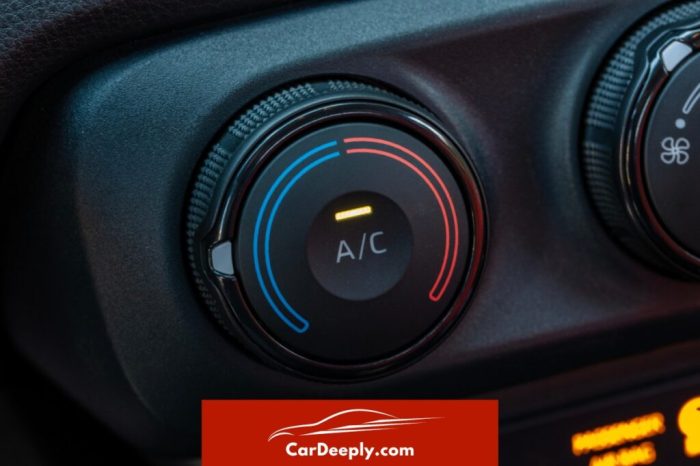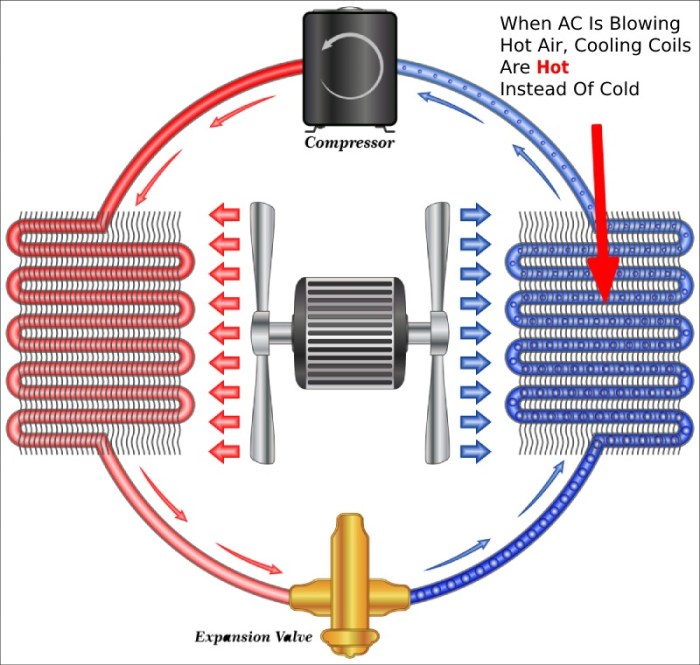Why is my car AC blowing warm air? That’s a seriously bummer question, especially during a heatwave. It’s like your car’s decided to stage a passive-aggressive revolt against your comfort. But fear not, fellow driver! This isn’t necessarily a death sentence for your summer road trips. We’ll break down the most common culprits behind your suddenly toasty air conditioning, from low refrigerant to electrical gremlins.
Get ready to become a mini-AC mechanic – at least enough to diagnose the problem and maybe save yourself a hefty repair bill.
Several factors can contribute to your car’s AC blowing warm air. These range from simple fixes like low refrigerant to more complex issues involving the compressor, blower motor, condenser, evaporator, or even electrical problems. Understanding the role of each component in the AC system is key to pinpointing the problem. We’ll explore each possibility, providing you with the knowledge to confidently tackle the issue, or at least have a more informed conversation with your mechanic.
Low Refrigerant Levels
So, your car’s AC is blowing warm air – bummer, right? One of the most common culprits is low refrigerant. This isn’t just some minor inconvenience; it can seriously impact your car’s AC system’s efficiency and even lead to more expensive repairs down the road. Let’s dive into why your refrigerant might be low and what you can do about it.Refrigerant loss in a car’s AC system happens gradually, often due to tiny leaks in the system’s components.
These leaks can develop over time due to corrosion, wear and tear, or even damage from road debris. Think of it like a tiny pinhole in a water balloon – you won’t notice a huge leak immediately, but over time, the water (or in this case, refrigerant) will slowly seep out. The refrigerant itself is under high pressure, so even a small hole can lead to significant loss over several months or even years.
The location of the leak can vary widely, from seals and o-rings to the condenser, evaporator, or even the compressor itself.
Signs and Symptoms of Low Refrigerant
Low refrigerant levels manifest in more ways than just warm air. While warm air is the most obvious symptom, you might also notice a lack of cool air even when the AC is running on full blast. The system might also cycle on and off more frequently than usual, struggling to maintain a consistent temperature. In some cases, you might even hear unusual noises coming from the AC compressor, like a hissing sound indicating a leak.
Finally, ice forming on the evaporator coil (though you won’t see this without disassembling parts of the system) can be another indicator of low refrigerant, often accompanied by restricted airflow.
Checking Refrigerant Level (A Conceptual Guide)
Checking refrigerant levels requires specialized tools and knowledge, and it’s generally best left to professionals. However, understanding the process can help you communicate effectively with a mechanic. Typically, a technician would use gauges connected to the system’s low-pressure and high-pressure ports to measure the refrigerant pressure. These gauges provide readings that, when compared to manufacturer specifications for your specific vehicle, indicate whether the refrigerant level is adequate.
The process also involves checking for leaks using a leak detection dye or electronic leak detector. A visual inspection of the AC components is also performed to check for obvious signs of damage or leaks. Remember, attempting this yourself without proper training and equipment can be dangerous due to the high-pressure refrigerant.
Effects of Different Refrigerant Leaks on AC Performance
| Leak Size | Initial Symptoms | Long-Term Effects | Time to Noticeable Impact |
|---|---|---|---|
| Microscopic (pinhole) | Subtle decrease in cooling, slightly warmer air | Complete loss of cooling, potential compressor damage | Months to years |
| Small (crack in a line) | Noticeable decrease in cooling, frequent cycling | Significant loss of cooling, potential system failure | Weeks to months |
| Large (major component failure) | Immediate loss of cooling, potential hissing sound | Complete system failure, requiring major repairs | Immediate |
| No Leak (Other Issue) | Warm air, but other issues present (like a failed compressor) | System malfunction, requiring repairs unrelated to refrigerant | Varies depending on the issue |
Compressor Issues
Okay, so you’ve checked your refrigerant, and your car’s AC isstill* blowing warm air? The next big suspect is the AC compressor. This little workhorse is the heart of your air conditioning system, and if it’s not functioning correctly, you’re going to feel the heat.The AC compressor is essentially a pump. It’s responsible for circulating refrigerant throughout the system, compressing it to a high pressure.
This high-pressure refrigerant then travels to the condenser, where it releases heat and turns back into a liquid. This liquid then passes through an expansion valve, lowering its pressure before finally entering the evaporator, where it absorbs heat from the inside of your car and cools the air. The whole cycle relies on the compressor doing its job.
Compressor Problems Resulting in Warm Air
A malfunctioning compressor can manifest in several ways, all leading to the same frustrating result: warm air blowing from your vents. The compressor might be struggling to maintain the necessary pressure, or it might be failing altogether. This can be due to a variety of issues, including worn-out parts, electrical problems, or a lack of lubrication.
Failing versus Seized Compressor
A failing compressor gradually loses its efficiency. You might notice a gradual decrease in cooling power over time, with the air becoming progressively warmer. The compressor might still cycle on and off, but it won’t be able to build the necessary pressure to cool the air effectively. You might also hear unusual noises, like a clicking or rattling sound, emanating from the compressor itself.
Think of it like an aging athlete – they can still participate, but their performance is significantly diminished.A seized compressor, on the other hand, is completely stuck. It’s not even attempting to do its job. This usually results in an immediate and complete loss of cooling. You won’t hear the compressor cycling at all, and there might be a noticeable lack of pressure in the system.
This is more like an athlete with a major injury – completely sidelined and unable to perform.
Diagnosing a Faulty Compressor
Diagnosing a compressor problem often requires a professional mechanic. However, there are some things you can check yourself. First, listen carefully for any unusual noises coming from the compressor. A clicking, rattling, or grinding sound can indicate a problem. Second, feel the compressor’s suction and discharge lines.
If the discharge line (usually the thicker one) is significantly cooler than the suction line, that could suggest a problem with the compressor’s ability to compress the refrigerant. A significant difference in temperature between these two lines is a good indication of a compressor problem. Third, check the compressor clutch. The clutch engages and disengages the compressor, and a malfunctioning clutch can prevent the compressor from working.
A visual inspection, checking for any obvious damage, and testing the clutch’s electromagnetic engagement can be done, though professional tools may provide more precise measurements. Ultimately, a professional AC diagnostic tool can provide the most definitive diagnosis.
Blower Motor Problems: Why Is My Car AC Blowing Warm Air?

Your car’s air conditioning system relies on more than just refrigerant; it needs a functioning blower motor to actually push the cooled air into your cabin. Think of the blower motor as the lungs of your AC system – it’s responsible for circulating the air. Without it, even perfectly chilled refrigerant won’t make your car cool.A malfunctioning blower motor is a common culprit behind warm air blowing from your vents, even if your refrigerant levels are fine and the compressor is working.
A problem with the blower motor prevents the cooled air from reaching you, regardless of how cold the air is at the point where the blower motor picks it up.
Blower Motor Failure Manifestations, Why is my car AC blowing warm air?
Several issues can cause a blower motor to fail or perform poorly, resulting in warm air. These issues can range from simple electrical problems to mechanical failures within the motor itself. A weakened or failing blower motor might produce a weaker airflow, a high-pitched whine, or even fail completely, leaving you with no airflow at all.
Common Blower Motor Failures and Their Symptoms
Problems with the blower motor often manifest in a few key ways. For example, a completely dead motor will result in no air blowing from the vents, regardless of the AC settings. A partially failed motor might produce weak airflow, particularly on lower fan speeds, or it might exhibit an unusual high-pitched whine or grinding noise while running.
Sometimes, the blower motor might work intermittently, turning on and off unpredictably. These symptoms indicate a need for investigation and likely replacement of the blower motor.
Troubleshooting a Blower Motor Issue
A simple flowchart can guide you through troubleshooting a suspected blower motor problem.
So, your car AC is blowing warm air? That usually means you’ve got a refrigerant leak, and low Freon is a common culprit. Figuring out the cost to fix this can be tricky, so check out this site for info on the Cost to recharge car AC with Freon before you head to the mechanic. Knowing the potential cost beforehand will help you decide whether to just recharge or dive into a deeper fix for your warm-air problem.
Condenser Issues

Your car’s AC system relies on a complex interplay of components to keep you cool. One crucial part often overlooked is the condenser, a component whose failure can significantly impact your system’s ability to produce cold air. Understanding its function and potential problems is key to diagnosing warm air issues.The condenser’s primary job is to release heat from the refrigerant.
Think of it as a radiator for your AC system. High-pressure, hot refrigerant from the compressor flows through the condenser’s many small tubes. As this refrigerant passes through, heat dissipates into the surrounding air, causing the refrigerant to change from a hot gas to a cooler liquid. This crucial phase change is essential for the subsequent cooling process within the evaporator.
Without a properly functioning condenser, the refrigerant can’t effectively release heat, leading directly to warm air blowing from your vents.
Condenser Clogging and Damage Effects on Cooling
A clogged or damaged condenser severely restricts the refrigerant’s ability to shed heat. Imagine trying to cool a pot of boiling water with a lid on – it takes much longer, and the water may not cool down efficiently. Similarly, a condenser obstructed by debris or damaged internally limits the surface area available for heat transfer. This leads to higher refrigerant temperatures entering the expansion valve and ultimately reduces the system’s cooling capacity, resulting in warm air output.
The pressure within the system may also increase, potentially stressing other components.
Appearance of a Damaged Condenser
A damaged condenser might exhibit several visual signs. A heavily clogged condenser might appear coated in a thick layer of dirt, leaves, or insect debris, particularly on the fins. These fins, which resemble tightly packed metal combs, are crucial for maximizing surface area for heat dissipation. Damage to these fins, often appearing as bent, broken, or crushed sections, severely impairs their functionality.
You might also see leaks, indicated by oily stains or refrigerant residue near the condenser’s seams or connections. In severe cases, the condenser might show signs of corrosion, with pitting or discoloration of the metal. A severely damaged condenser may even have noticeable punctures or holes.
Causes of Condenser Damage
Several factors can contribute to condenser damage. Here’s a list of common culprits:
- Road debris impacts: Rocks, pebbles, and other road debris can easily damage the delicate condenser fins during driving.
- Corrosion: Exposure to road salt and other corrosive elements can weaken the condenser over time.
- Vibrations: Excessive vibrations from the engine or other components can lead to fin damage or leaks.
- Manufacturing defects: While less common, faulty manufacturing can result in weaknesses in the condenser’s construction.
- Collisions: A front-end collision can easily crush or puncture the condenser.
Evaporator Issues
The evaporator is a crucial component in your car’s AC system, responsible for actually cooling the air you feel coming from your vents. Think of it as the heart of the cooling process, where refrigerant absorbs heat from the air inside your car. A problem with the evaporator can significantly impact your AC’s ability to blow cold air, leading to warm air blowing from the vents.The evaporator is essentially a heat exchanger, a network of coils filled with refrigerant.
As warm air from the cabin passes over these cold coils, the heat transfers from the air to the refrigerant, cooling the air and warming the refrigerant. This cooled air is then blown into the cabin through your vents. Several issues can disrupt this process.
So, your car AC is blowing warm air? That totally sucks, especially in Miami. Maybe you need to check your refrigerant levels, or maybe it’s something more serious. If you’re cruising around in a seriously sweet ride, though, you might want to check out Top-rated luxury tuners in Miami 2025 to make sure everything’s running smoothly.
But first, figure out that AC issue – you don’t want to be sweating while you’re showing off your pimped-out ride!
Evaporator Failure Modes
A clogged or dirty evaporator is a common culprit behind warm air. Dust, debris, and even mold can accumulate on the evaporator coils, reducing their efficiency in absorbing heat. This buildup acts as an insulator, preventing effective heat transfer. Another potential problem is a leak in the evaporator itself. If the evaporator is punctured or cracked, refrigerant can leak out, significantly reducing its cooling capacity.
A completely clogged evaporator or a major leak will render the system useless, while minor blockages can cause reduced cooling.
Evaporator Cleaning and Replacement
Cleaning a dirty evaporator typically involves accessing the evaporator core, usually located behind the dashboard. This is a complex process often requiring professional help due to the intricate nature of the dashboard disassembly. A professional technician will use specialized cleaning agents and tools to remove the buildup from the evaporator coils. In some cases, this might involve using high-pressure air or specialized cleaning solutions to dislodge debris and restore airflow.
Replacement, on the other hand, is a much more extensive repair. It involves removing the old evaporator and installing a new one, a task that requires a good deal of technical expertise and precision to avoid damaging other parts of the system. The cost of replacement will naturally be higher than a cleaning, but it’s the only option when the evaporator is severely damaged or beyond repair.
Comparing Evaporator and Condenser Issues
While both the evaporator and condenser are essential for proper AC function, their failure manifests differently. A faulty evaporator will usually result in warm air blowing from the vents, even if the compressor is running and the refrigerant level is sufficient. The air may not be completely warm, but it will be significantly less cool than expected. A faulty condenser, on the other hand, often leads to reduced cooling capacity, but not necessarily warm air.
You might experience lukewarm air instead of cold air, or the AC might take a longer time to cool down the cabin. Furthermore, condenser issues often result in a noticeable increase in the compressor’s operating time as it struggles to cool the refrigerant. A faulty condenser might also exhibit visible signs of damage, such as leaks or dents, which are usually not directly visible with evaporator problems.
In essence, while both result in sub-optimal cooling, a failing evaporator results in a more dramatic drop in cooling performance, often producing noticeably warm air.
Electrical Problems
Your car’s AC system relies on a complex electrical circuit to function correctly. Problems within this circuit, from blown fuses to damaged wiring, can easily prevent your AC from blowing cold air, resulting in that frustrating warm air blast. Let’s examine the common culprits.Electrical issues are often overlooked when troubleshooting a car’s AC system, but they’re surprisingly common and can be relatively easy to fix.
A simple visual inspection can often pinpoint the problem.
AC System Electrical Components
The electrical components of your car’s AC system work together to control the compressor, blower motor, and other crucial parts. These components include the AC compressor clutch relay, the blower motor resistor, the AC control module (often part of the main vehicle control module), and various fuses and wiring harnesses connecting them all. A malfunction in any of these parts can disrupt the system’s operation.
For example, a faulty relay might prevent the compressor from engaging, while a bad blower motor resistor could limit the fan’s speed, resulting in weak or warm airflow.
Blown Fuse or Faulty Relay Effects
A blown fuse or a malfunctioning relay will interrupt the electrical flow to parts of the AC system. The AC compressor, for instance, requires power to engage and compress the refrigerant. If the fuse protecting the compressor circuit is blown, the compressor won’t turn on, leading to warm air. Similarly, a faulty relay, which acts as a switch, may fail to send power to the compressor or blower motor, causing the same issue.
This can be diagnosed by checking the fuse box for a blown fuse (a visibly broken filament) or testing the relay using a multimeter to check continuity.
Wiring Harness Inspection
Visually inspecting the wiring harnesses is crucial. These harnesses can become damaged due to age, wear and tear, rodent activity, or even accidental damage during repairs. Look for any signs of fraying, broken wires, corrosion, or loose connections. Pay close attention to the harnesses near the compressor, blower motor, and the AC control unit. Corrosion often appears as a greenish or whitish buildup on the wire terminals.
Fraying or exposed wires can cause shorts or open circuits, disrupting the AC system’s electrical flow. A simple visual inspection can often reveal these problems, allowing for a straightforward repair. If you find damaged wiring, carefully repair or replace the affected sections. Remember to disconnect the battery’s negative terminal before any electrical work.
Blend Door Issues
Your car’s air conditioning system doesn’t just cool the air; it also blends it with outside air to achieve the desired temperature. A key component in this process is the blend door, a small flap that regulates the flow of hot and cold air. If it malfunctions, your carefully chosen temperature setting might be completely ignored.The blend door acts like a valve, controlling the mix of air from your heater core (hot) and the evaporator (cold).
It’s typically a motorized flap located within your HVAC system’s ductwork. When you adjust the temperature control, a motor moves the blend door to change the proportion of hot and cold air that reaches your vents. A malfunctioning blend door might get stuck in a position that favors warm air, regardless of your temperature setting.
Blend Door Malfunction Diagnosis
Diagnosing a faulty blend door often involves a process of elimination, since other AC components can also cause warm air issues. However, certain clues point towards a blend door problem. If your AC blows cold air on some vents but warm air on others, this is a strong indicator. Additionally, if the temperature changes erratically or doesn’t respond to your temperature adjustments, a blend door issue is a likely suspect.
A visual inspection, though sometimes difficult due to the blend door’s location, might reveal a broken or dislodged door.
Blend Door Mechanism Diagram
Imagine a rectangular box representing the HVAC housing. Inside, near the air vents, is a pivoting flap—the blend door. One side of the flap connects to a shaft driven by a small electric motor. On one side of the blend door is the cold air duct from the evaporator, and on the other is the hot air duct from the heater core.
When the temperature control is set to cold, the motor rotates the shaft, moving the blend door to block the hot air duct and allow only cold air to flow to the vents. Conversely, when set to hot, the blend door blocks the cold air duct, allowing only hot air to pass through. A cable or linkage mechanism might be present instead of a direct motor connection, but the principle remains the same: the blend door acts as a gate controlling the airflow.
The motor receives its signal from the climate control system’s electronic control unit (ECU). If the motor fails, the blend door remains stationary, leading to inconsistent air temperature.
System Leaks
A leaky AC system is a common culprit behind warm air blowing from your car’s vents. Even a small leak can significantly reduce the refrigerant level, impacting cooling performance. Understanding the types of leaks and how to potentially identify them is crucial for effective diagnosis and repair.Leaks can occur in various parts of the system, stemming from a variety of causes.
These range from tiny pinholes caused by corrosion or road debris to larger cracks resulting from damage or wear and tear. The materials used in the seals and components themselves also play a significant role in leak susceptibility.
Types of AC System Leaks
Different types of leaks manifest in different ways, affecting the rate at which refrigerant escapes. Slow leaks, often the result of small pinholes or degraded seals, may be harder to detect immediately. Faster leaks, such as those caused by a major crack or a disconnected line, will usually be more obvious due to a rapid decrease in cooling capacity.
The location of the leak will also affect how quickly the refrigerant is lost. Leaks near the compressor, for example, may cause a noticeable drop in pressure more quickly than leaks in less accessible areas.
AC System Seal Materials and Vulnerabilities
The seals and components within your car’s AC system are typically made from materials designed to withstand pressure and exposure to refrigerants. However, these materials aren’t indestructible. O-rings, for instance, often made of rubber, can degrade over time due to age, exposure to chemicals, and extreme temperatures. This degradation can lead to cracking and ultimately, leaks. Similarly, metal components can corrode, especially in areas exposed to moisture and road salt.
Corrosion can create pinholes that allow refrigerant to escape slowly, leading to a gradual loss of cooling power. The seals on the compressor, condenser, and evaporator are particularly vulnerable due to their constant exposure to pressure and refrigerant.
Identifying the Source of a Leak
Pinpointing the exact location of a leak without specialized equipment can be challenging. However, you can often narrow down the possibilities by carefully observing the system for signs of refrigerant leaks. Look for oily residue or frost buildup near potential leak points. Oily residue often indicates a leak of refrigerant oil, which is mixed with the refrigerant.
Frost can form around leaks in low-pressure areas, such as the evaporator. Keep in mind that this visual inspection is limited; a professional leak detection service is usually needed for precise identification.
Potential Leak Locations
Locating a leak requires a systematic approach. Here are some of the most common areas where leaks can occur:
- Compressor seals
- Condenser fins and connections
- Evaporator core and connections
- O-rings on various components
- Hoses and lines (especially at connection points)
- Receiver/dryer
Concluding Remarks

So, your car’s AC is blowing warm air? Don’t sweat it (pun intended!). While it can be frustrating, understanding the potential causes—from a simple refrigerant leak to a more serious compressor issue—empowers you to take control. By systematically checking the various components, you can often narrow down the problem and either fix it yourself or provide your mechanic with valuable information.
Remember, a little knowledge can go a long way in keeping you cool and comfortable on the road. Now get out there and enjoy that A/C (hopefully!).









